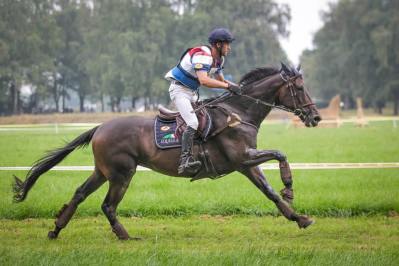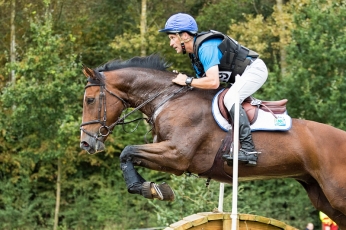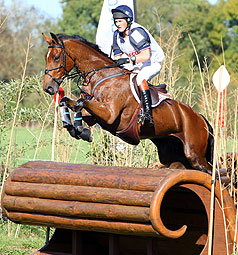If you’ve read this blog more than like… once before, it’s probably no secret that I am a huge nerd about all things breeding related. I tend to watch every live stream with a pedigree database open in another window, looking up every horse. For WEG I decided to take it a few hundred steps farther and make an actual spreadsheet, so I could see all the horses together and pull some stats. It’s possible that I spent far too many hours doing this, but I regret nothing.
These stats are for just the eventing horses at WEG. I threw out the couple of horses that I could not find any reliable damline information on, lest they skew things incorrectly – they aren’t included in any stats. That left us with a field of 81.

Why it’s important to look at the pedigree and not the registry
Irish Sporthorse and Selle Francais are the most represented breed registries with 14 horses each. Of the 14 Irish horses, only 5 of these are of “traditional” Irish breeding – ie some mix of Irish Draught and Thoroughbred, with no European warmblood. One is WB x TB with no traditional Irish blood, leaving the remaining 8 to be some mixture of ID/ISH x TB x WB.
On the flip side, all 14 of the Selle Francais registered horses have Selle Francais blood, with only 3 of those not being completely of French descent.

Several of the same stallions show up repeatedly throughout the field
Heraldik xx shows up in the pedigree of four different horses, three times as the sire (the most of any in the field) and once as the damsire.
Contender shows up five times: four times as the sire’s sire and once as the sire’s grandsire. His son Contendro is the sire of 2 horses and the sire’s sire of one.
Irco Marco shows up 4 times, two of which are through his son Irco Mena.
Diamant de Semilly, Jaguar Mail, and Jumbo are represented by two direct offspring each.
Quidam de Revel and Landgraf show up somewhere in the first four generations a remarkable 6 times each. Ramiro shows up 5 times in the same span.

Thoroughbred/Arab/AA blood is still important
The average “blood” percentage for the WEG field is 62% (highest – 100%, lowest – 27%).
72% of the field has at least 50% blood.
37% (30 horses) have at least one FULL thoroughbred parent.
Of those 30 horses, 17 are F1 crosses between a WB and a TB. 7 have the thoroughbred parent as the sire, and 10 have the thoroughbred parent as the dam.
Five horses are full thoroughbred.
The most represented American thoroughbred is Danzig, showing up in the first 4 generations in 5 different horses. Sir Gaylord and Nijinsky also make multiple appearances.

- Henri Z, by Heraldik xx
The influence of the registries known to produce mostly showjumpers is evident
47% have Holsteiner blood in the first 4 generations of their pedigree.
41% have Selle Francais in the first 4 generations of their pedigree.
19% have both Holsteiner AND Selle Francais in the first 4 generations.

The FEI Young Horse classes have a pretty high success rate
51% of the field (42 horses) competed in FEI Young horse classes – ie 1* for 6yo’s and/or 2* for 7yo’s. Of those, 28 horses (so 34% of the entire field) competed at the World Young Event Horse Championships at Lion d’Angers.

My general takeaways:
The average blood percentage is lower than I would have thought. I want to break down a “real” top level event like Burghley or Badminton… I have a feeling the average blood percentage would be higher for an event like that.
Having been a pedigree stalker for a long time, none of the stallions that show up over and over again are surprising to me. However, I was a little surprised at the strong showing from the Selle Francais in general. There are more than I thought.
The F1 cross of a warmblood stallion to a TB mare has kind of gotten a bad rap in this country for being a lower quality cross, but these stats show that it certainly can and does work when it comes to breeding event horses.
The fact that Holsteiner blood shows up in the first 4 generations of almost half the field yet only 6 of the horses are actually registered Holsteiner shows how important these bloodlines have been across a wide variety of warmblood registries.
Lastly, despite the fact that some of us may wince at the idea of a 6yo competing 1* or a 7yo competing 2*, clearly it works when it comes to producing upper level horses. Over half of these horses have come up through that path and continued up the levels to find success. And 1/3 of them having competed at Lion d’Angers – that’s a big chunk!
If anyone is actually still reading by this point… what are your takeaways from this? Anything surprising?

my takeaway is i don’t understand half of your number crunching but it is interesting seeing it broke down like that. You should totally do that with a big event just for funnsy (And to make you use your brain even more) 🙂 HA HA
And I don’t like 6 year olds doing that much but they definitely have a plan down to do that. they have to be some of the most well prepared youngsters I have ever seen (when I saw the Young Horse classes at FHI for example)…..crazy how well those 4 and 5 year olds were trained. And not over trained either. Just well behaved, and there to do their job.
LikeLike
Interesting. I would have thought the blood percentage would be higher..not surprised about the Selle Francais influence. That has been happening in sj as well in the last few years.
Mostly, the european WB registries are interchangeable. I always say that our wbs are “glorified mutts” because a horse registered with the Holsteiner registry can have a Hannoveranian dam and a Oldenburger sire who in turn has a tb sire.. They ‘re a ll mixed together and are really similar in type as well.
Do you think that the cross of tb and wb is less frowned upon here in Europe because the tbs have to go through the samevinspection the wbs do to be entered into stu d and mare books? That the selection is different? Or do we just havea lot of catching up to do with the amount of blooded horses we use to breed sporthorses?
LikeLike
Yeah I see a lot of people who don’t know a lot about breeding just look at “Hanoverian” and “Holsteiner” and “Dutch” and “Irish” and think those are separate things…. but these days they most certainly aren’t. It’s so important to look at the actual pedigree that just stopping at the breed registry is almost useless!
As far as the TB dams, I think that in America we just have SO MANY thoroughbreds, and not a ton of nice warmblood mares, that a lot of people see a TB mare as a cheap/lesser option. Even if she scores well and is accepted into the same mare book as other mares, many people still see them as “less than”. There are even big European breeders that won’t use a full TB mare, because they think the mareline is more important and therefore the warmblood should stay on the bottom. Which I don’t generally disagree with, but clearly it can be done either way and have success.
LikeLike
Only Trakehners and maybe some eastern european breeds are really a breed apart.
It’s so stupid how many people are so prejudiced against certain breeds…stbs are in the same boat, maybe more so and they are such versatile horses. Halla, Wincklers wonder horse, was stb bred. You’d think people would learn…
LikeLike
My favorite thing is when someone says “Dutch Warmbloods are my favorite breed!”. LOL. Righto.
LikeLiked by 1 person
Right?? They could really throw all registries together and call it a day..
Did you see Chipmunk and Krajewski?
Won the BC at five in 2013 and in Le Lion d’Angers in 2015. And in Aachen this year. They won the german championship as well this year. Contendro I x Heraldik xx. I think they’re still in the lead with a great dressage score of 19.90.
LikeLike
Yeah Chipmunk is really bred to the nines for this job! Such a stunning horse. He is one of the pictures in the post.
LikeLike
Love this! After studying Lisa’s broodmare band and foals for years, I very anecdotally and unscientifically think that the mare’s temperament/attitude influences the foal’s temperament, which makes the WB stallion/TB mare cross more attractive to me as an event horse than the other way around. Not that there’s anything wrong with the WB temperament but I love the “I would jump through fire for you” attitude TBs tend to have (even if it scares me, personally, to pieces haha). It has to be a well-built TB mare though, I can see the bias coming in just from the fact that some breeders still don’t take the quality of the mare as seriously as they do the stallion, and they’re breeding poor quality TB mares to good quality WB stallions and wondering why the stallion doesn’t improve the mare more.
LikeLike
Henny is from the Danzig line, yes? Makes a lot of sense then with his “game-on” attitude for xc.
The takeaway for me: need a horse by the Danzig line out of a mare with a weeeee bit of Selle Francaise.
That said, would love to know injury/illness stats on these bloodlines. Colic incidents, suspensory, lameness, choking, etc. As an a/o, longevity/useability is a big factor. I know we all get PPEs and accidents are expected, but a risk assessment would be a dream. If that makes sense
LikeLike
Yes, Henry is from the Danzig line. And Presto has Heraldik. 😉 My two favorite TB lines (totally unbiased, of course).
We have a few good full TB sporthorse/eventing stallions in this country from the Danzig line – Sea Lion and Sea Accounts being two of them.
LikeLike
I think the success of the horses coming up via the Young Horse stuff confirms the research that has been published this year about TBs being hardier if they run as 2yos. At the end of the day, starting work young makes for stronger bones. In my opinion, it is just a matter of how hard and how often they get worked while they are still growing and developing. I LOVE when you do these posts! Feel free to do the show jumpers as well. 😉
LikeLike
The jumpers are a little more boring to me lol. They’re jumping blood upon jumping blood upon jumping blood, with few surprises. I suppose the interesting thing would be blood percentage. Maybe once WEG is over I’ll go back and break down the top 20 in each of the Olympic disciplines and see what we’ve got.
LikeLiked by 1 person
Great analysis. Obviously, there are certain crosses that work- and event breeders should take note
LikeLike
You seem to have done so! 😉
LikeLike
“Lastly, despite the fact that some of us may wince at the idea of a 6yo competing 1* or a 7yo competing 2*, clearly it works when it comes to producing upper level horses. Over half of these horses have come up through that path and continued up the levels to find success.”
So I’m wondering about causation/correlation here. I’m far from an expert on the young horse events, but my understanding of the objections is that people are nervous about stressing joints/tendons/brains at that age. So I wonder if it would make sense to unpack this a little bit more?
On the one hand: yes, it seems that the YEH/FEH stuff does a good job at identifying talented young horses, of flagging those that have upper level potential. If a high number of them do well at those events and then go on to WEG and other top level events, that’s a good sign for the theory behind the young horse events.
But I think it’s a step further to argue that those events *produce* upper level horses. I think there are a couple of things: selection bias (if you don’t have a nice young horse that’s a likely candidate as a nice eventer, you won’t go that route anyway), age of the horses (I’d love to see the average age of a horse that’s gone through the program – are they younger than the other WEG horses? Are they retired earlier?).
Either way, it’s really interesting that so many of them came up through that program, and I think it’s an overall positive piece of data, but I think that it needs a little more digging!
LikeLiked by 1 person
There’s a lot more to it than even that, really. They are definitely the best of the best young horses in the world (who had to qualify to get to Lion in the first place) ridden by the best riders in the world. Naturally they are set up for success moreso than others. Is it more of a “if you get to Lion, you’ve probably got a bright future” or is it a “Lion makes a bright future”? Probably the former. You don’t get to Lion unless you’re looking like a possible superstar right from the beginning.
What’s interesting to me is that many people are concerned that horses competing at that level at that age will not last to see a 3* or 4* career… but if you go back and look at horse after horse, a very large portion of them do. Many of them enjoy a LONG career at that level, too (Michael Jung’s Sam being a good example – he competed at Lion as both a 6yo and a 7yo). And of the ones that never progress further up the levels, a vast many of THOSE can be found enjoying a career with a junior or amateur at the lower levels. Is that because they were sound enough to withstand the rigors of an early career, and thus probably also built to withstand the rigors of the higher levels? Is it because they have access to the best care? Is it because their riders are more educated, thus don’t have to “pound” on their young horses as much to get the same results? Could be all, any, or none of those things, really.
It’s interesting to track the early careers of these horses (which is markedly more difficult to do before they got to FEI level, of course) and see when they started and where. The vast majority of the ones that I have ever looked up (I do a lot of weird things in my spare time) can be traced back to competition results, at some level, as 4yos.
LikeLike
Thank you, that was a really interesting additional explanation!
LikeLike
I’m not a breeding nerd, so no real takeaway. But a few random thoughts for you:
Holsteiners are my favorite. Though Jamp was a registered Austrian Warmblood breeding stallion, his bloodlines are actually holsteiner. Rio is too.
We had a Heraldik stallion at my barn where I used to board. He was very talented but he was a total dick. Might have been a better gelding though?
I don’t give much attention to the Selle Francais, but I think maybe I should.
LikeLike
What are some thoughts about TB breeding in dressage?
LikeLike
I can’t pretend to know enough about straight dressage breeding to even speculate on that lol. They like things that I do not!
LikeLike
I do data analytics as my job and if you have a dataset to pass on with the info about blood percentages and pedigrees, I’d be interested in running some analyses to see which factors are most correlated with eventing success…could even try some predictive modeling if the dataset is big enough (with the caveat that of course, horses are living creatures that can end up quite different than expected and that the trainers involved make a difference, though ideally the training would be somewhat controlled for by the fact that they’re all higher level horses)
LikeLike
Another vote for you doing the analysis for the jumpers 🙂
LikeLike
Re coming up the levels at younger ages than most of us think is, well, wise …
Having watched a UL rider start horses age 4-6, as future UL horses, they don’t hang around plinking over crossrails. It isn’t so much that the horse ‘trains’ over bigger jumps, as in learning striding and becoming bridlewise and all that. It’s that they are shown from the get-go “you are a mighty athlete and this ole 3’6″ oxer ain’t nuthin to you”.
The horses were free-jumping over what I would think of as larger oxers from early days, from the minute they get the idea about going around a round pen or longe line (days or just a few weeks from commencement of training). Not being highly directed other than that by round-pen size and jump placement they self-regulated their pace down. They very quickly got the idea that they could easily spring over a 3’6″ with a 4″ spread right out of stride, as easily as they could do a natural gallop. They weren’t muscling over it as we so often ask our horses to do, they were just boinging out of their own energy. THAT is what they learned very, very early.
These future UL horses started competing at Training level. The records of many top-level horses show the same thing in the USEA record (although of course we don’t know what they did, unrated). The trainer brought them up to Prelim pretty fast and spent a year or so there. The horses were expected to get their seasoning at the tougher Prelims and at Intermediate.
That’s not for me, but I’m as ammy as they come. 🙂 It was about making the most of a very powerful horse by creating their reality. These aren’t big jumps, my dear horse-child, these are just average jumps like we do all the time. As a very strong and athletic animal, they were able to cope with that.
That’s what I observed, for whatever it’s worth.
LikeLike
This makes so much sense to me.
LikeLike